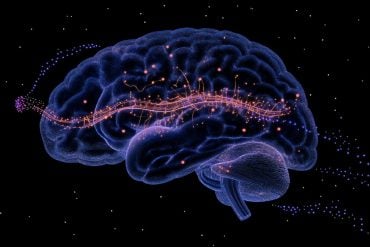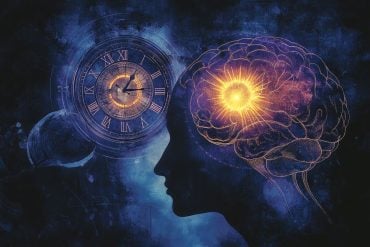Summary: Researchers report virtual reality can help to lower pain levels and increase performance when undertaking physical activity. Participants using VR reported a pain intensity 10% lower than those not using the technology when performing isometric bicep curls.
Source: University of Kent.
The research, led by PhD candidate Maria Matsangidou from EDA, set out to determine how using VR while exercising could affect performance by measuring a raft of criteria: heart rate, including pain intensity, perceived exhaustion, time to exhaustion and private body consciousness.
To do this they monitored 80 individuals performing an isometric bicep curl set at 20% of the maximum weight they could lift, which they were then asked to hold for as long as possible. Half of the group acted as a control group who did the lift and hold inside a room that had a chair, a table and yoga mat on the floor.
The VR group were placed in the same room with the same items. They then put on a VR headset and saw the same environment, including a visual representation of an arm and the weight (see image below). They then carried out the same lift and hold as the non-VR group.
The results showed a clear reduction in perception of pain and effort when using VR technology. The data showed that after a minute the VR group had reported a pain intensity that was 10% lower than the non-VR group.
Furthermore the time to exhaustion for the VR group was around two minutes longer than those doing conventional exercise. The VR group also showed a lower heart rate of three beats per minute than the non-VR group.
Results from the study also showed no significant effect of private body consciousness on the positive impact of VR. Private body consciousness is the subjective awareness each of us has to bodily sensations.

Previous research has shown that individuals who have a high private body consciousness tend to better understand their body and as a result perceive higher pain when exercising. However, the study’s findings revealed that VR was effective in reducing perceived pain and that private body consciousness did not lessen this effect.
As such, the improvements shown by the VR group suggest that it could be a possible way to encourage less active people to exercise by reducing the perceived pain that exercise can cause and improving performance, regardless of private body consciousness.
Lead researcher Maria Matsangidou said: ‘It is clear from the data gathered that the use of VR technology can improve performance during exercise on a number of criteria. This could have major implications for exercise regimes for everyone, from occasional gym users to professional athletes.’
Dr Jim Ang from EDA and Dr Alex Mauger from the School of Sport and Exercise Sciences at Kent were also involved in the research.
Source: Dan Worth – University of Kent
Publisher: Organized by NeuroscienceNews.com.
Image Source: NeuroscienceNews.com image is credited to Maria Matsangidou.
Original Research: Abstract for “Is your virtual self as sensational as your real? Virtual Reality: The effect of body consciousness on the experience of exercise sensations” by Maria Matsangidou, Chee Siang Ang, Alexis R. Mauger, Jittrapol Intarasirisawat, Boris Otkhmezuri, and Marios N. Avraamides in Psychology of Sports and Exercise. Published July 18 2018.
doi:10.1016/j.psychsport.2018.07.004
[cbtabs][cbtab title=”MLA”]University of Kent”Virtual Reality Reduces Pain and Increases Performance During Exercise.” NeuroscienceNews. NeuroscienceNews, 1 October 2018.
<https://neurosciencenews.com/virtual-reality-pain-exercise-9941/>.[/cbtab][cbtab title=”APA”]University of Kent(2018, October 1). Virtual Reality Reduces Pain and Increases Performance During Exercise. NeuroscienceNews. Retrieved October 1, 2018 from https://neurosciencenews.com/virtual-reality-pain-exercise-9941/[/cbtab][cbtab title=”Chicago”]University of Kent”Virtual Reality Reduces Pain and Increases Performance During Exercise.” https://neurosciencenews.com/virtual-reality-pain-exercise-9941/ (accessed October 1, 2018).[/cbtab][/cbtabs]
Abstract
Is your virtual self as sensational as your real? Virtual Reality: The effect of body consciousness on the experience of exercise sensations
Objectives
Past research has shown that Virtual Reality (VR) is an effective method for reducing the perception of pain and effort associated with exercise. As pain and effort are subjective feelings, they are influenced by a variety of psychological factors, including one’s awareness of internal body sensations, known as Private Body Consciousness (PBC). The goal of the present study was to investigate whether the effectiveness of VR in reducing the feeling of exercise pain and effort is moderated by PBC.
Design and methods
Eighty participants were recruited to this study and were randomly assigned to a VR or a non-VR control group. All participants were required to maintain a 20% 1RM isometric bicep curl, whilst reporting ratings of pain intensity and perception of effort. Participants in the VR group completed the isometric bicep curl task whilst wearing a VR device which simulated an exercising environment. Participants in the non-VR group completed a conventional isometric bicep curl exercise without VR. Participants’ heart rate was continuously monitored along with time to exhaustion. A questionnaire was used to assess PBC.
Results
Participants in the VR group reported significantly lower pain and effort and exhibited longer time to exhaustion compared to the non-VR group. Notably, PBC had no effect on these measures and did not interact with the VR manipulation.
Conclusions
Results verified that VR during exercise could reduce negative sensations associated with exercise regardless of the levels of PBC.






